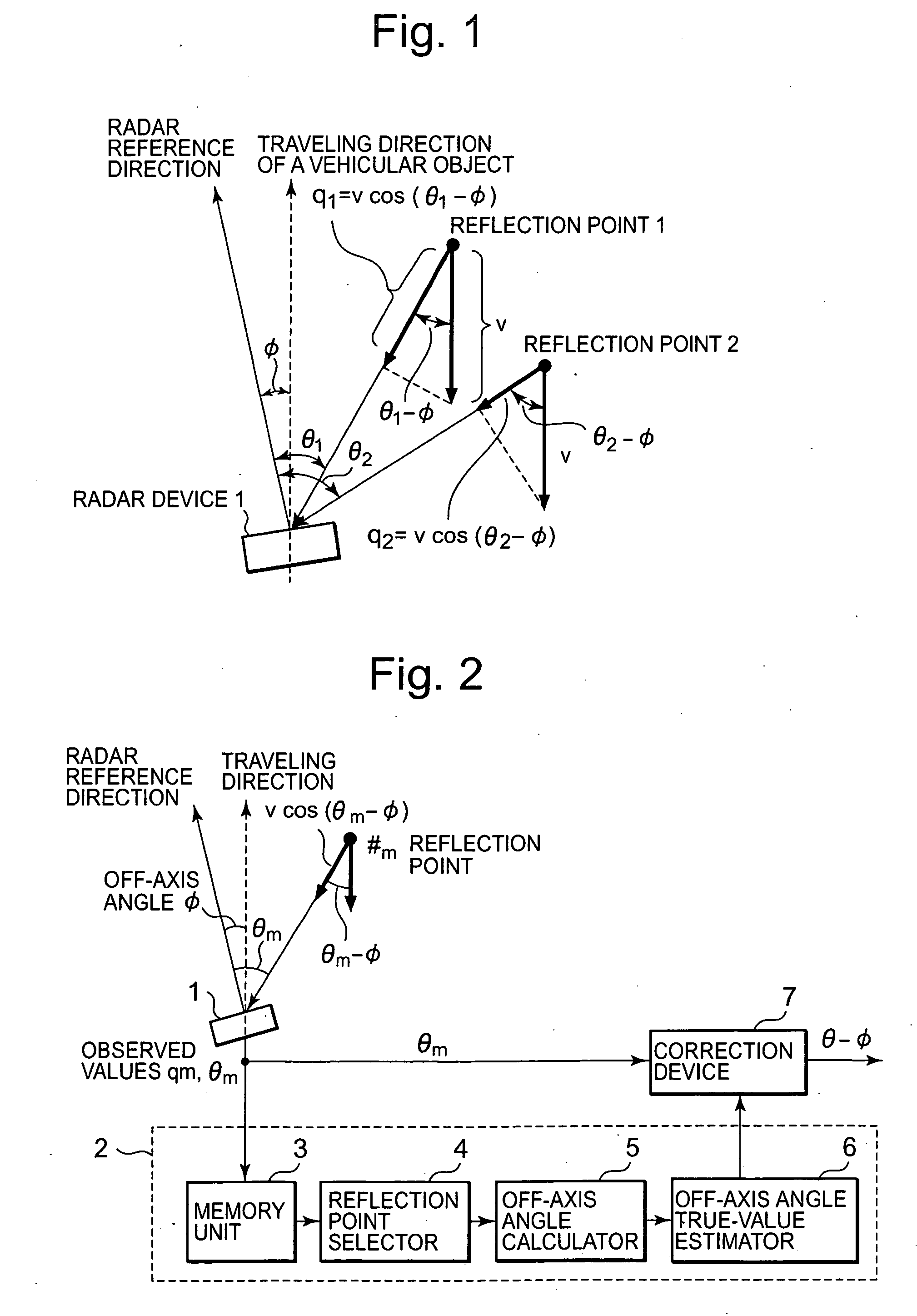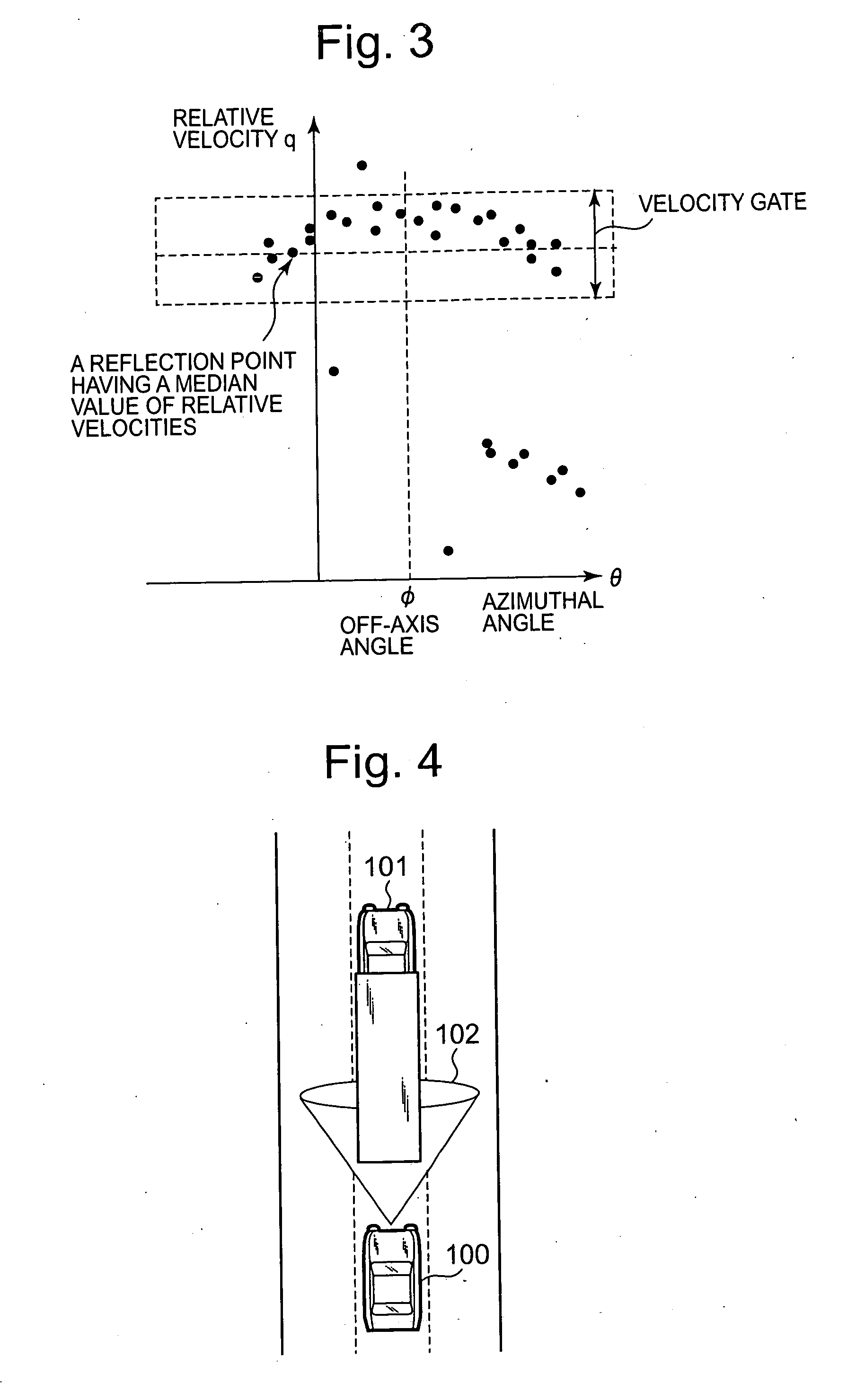Off-Axis Angle Estimation Method and Apparatus Using the Same
a technology of off-axis angle and estimation method, applied in the field of error estimation technologies, can solve the problems of poor initial work accuracy, incorrect azimuthal angle of radar reflector obtained as a result of processed radar signals, and misalignment of reference axis with actual use, and achieve the effect of stably achieving off-axis angle estimation
- Summary
- Abstract
- Description
- Claims
- Application Information
AI Technical Summary
Benefits of technology
Problems solved by technology
Method used
Image
Examples
embodiment 1
[0028] To begin with, the operating principles of an off-axis angle estimation method in Embodiment 1 of the present invention are explained. FIG. 1 is a conceptual diagram for explaining the operating principles in Embodiment 1 of the present invention. In FIG. 1, a radar device 1 is, for example, a radar device mounted on a vehicular object such as a motor vehicle. Moreover, a reflection point 1 and a reflection point 2 are points of reflecting radar waves, detected by the radar device 1.
[0029] The radar device 1 is provided for detecting other vehicles exist in a traveling direction of the vehicular object, and obstacles such as road installation facilities. When the radar device 1 detects obstacles and / or other vehicles, the detected result is outputted to devices that are external to the radar device 1, for example, to a vehicular clearance maintaining device, an adaptive cruise control device, and the like, which are provided for uses such as velocity controls and increased s...
embodiment 2
[0068] In the off-axis angle estimation device in Embodiment 1, reflection points are selected to have a median value of relative velocities as a reference velocity; however, instead of taking this manner, a reflection point having a maximum value among the relative velocities can be selected as the reference velocity. Namely, by assuming that the reflection point having the maximum value among the relative velocities is a reflection point on a road surface, a velocity gate (a range of values in which difference among the relative velocities to each other becomes within a predetermined value) is determined with reference to the relative velocity at the reflection point. Then, the reflection point selector 4 is allowed to select a plurality of reflection points that is included in the velocity gate.
[0069] For example, there may be an instance in which motor vehicles and the like driving on an express way have a velocity difference to a road surface that is significantly greater than...
embodiment 3
[0074] In the off-axis angle estimation method in Embodiment 1 or Embodiment 2, a configuration has been made in which a relative velocity at any one of reflection points is specified as the reference velocity, and reflection points are then selected so that relative velocities are included in a range of values having a predetermined width centering on the reference velocity. Instead of taking this manner, by finding a range of values in which a frequency becomes a predetermined number or greater in distribution of relative velocities, and by determining the range of values as a velocity gate, the reflection point selector 4 is allowed to select reflection points that are included in this range of values.
[0075] Equation (3) holds between two of the reflection points at which the relative-velocity components in the traveling direction of a vehicular object are approximately equal to one another. Therefore, not necessarily limited to reflection points on a road surface, it can be rea...
PUM
 Login to View More
Login to View More Abstract
Description
Claims
Application Information
 Login to View More
Login to View More - R&D
- Intellectual Property
- Life Sciences
- Materials
- Tech Scout
- Unparalleled Data Quality
- Higher Quality Content
- 60% Fewer Hallucinations
Browse by: Latest US Patents, China's latest patents, Technical Efficacy Thesaurus, Application Domain, Technology Topic, Popular Technical Reports.
© 2025 PatSnap. All rights reserved.Legal|Privacy policy|Modern Slavery Act Transparency Statement|Sitemap|About US| Contact US: help@patsnap.com



